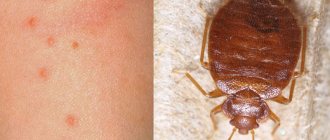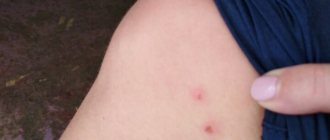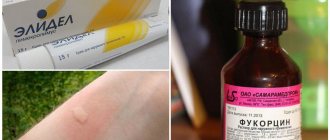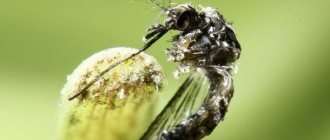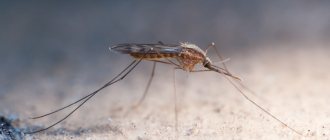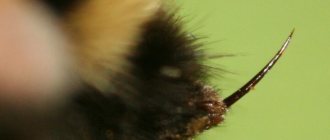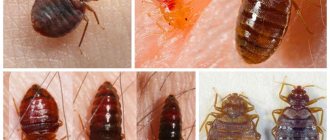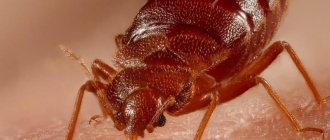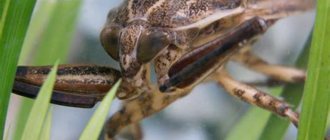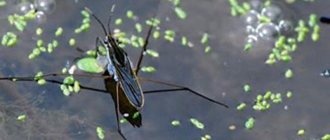We are used to being attacked by mosquitoes in the warm season. However, this is not the only blood-sucking insect that gives us trouble. Bedbug bites are similar to mosquito bites, so people do not even suspect that this insect is in the house. Knowing how to distinguish a mosquito bite from a bedbug bite, you can take timely measures to destroy the latter.
What is a bedbug?
This is a small wingless insect with a dense shell. It has a flat, brown body; it is almost impossible to discern other features. The bug is so small in size, especially while hungry, that it is even difficult to see. The average length of an insect is from 2 to 5 millimeters. It increases in size after feeding.
There is only one product in the bedbug's diet - human or animal blood. Not only adults, but also larvae feed on blood. During one meal, the bloodsucker makes several bites. So the harm from his presence in the house is much more noticeable than the presence of mosquitoes in the apartment.
Bed bugs love to live in warm houses. The ideal climate for them is the same as for humans. The comfortable temperature for their existence and reproduction is 20-25°C. Therefore, insect infestations are usually observed in summer.
Parasites multiply in huge numbers. Each female lays up to five hundred eggs. Conquerors can take over an entire house in a week.
How do bedbugs get into the house?
Insects can appear in the apartment at any time. They are simply “brought” into the house.
The cause of bedbugs can be:
- Purchases . Parasites can be delivered to your home from the store. Have you bought new furniture or household appliances? Bedbugs can live in packaging or in the cavities of furniture and will quickly take root in your apartment.
- From neighbors . If the neighboring room is infested with bedbugs, there is a high probability that bloodsuckers will appear in your home. Insects have a habit of wandering, conquering new territories. They will crawl from neighbors through the ventilation system, through cracks in ceilings or along an external wall.
- From the guests . You can bring a “gift” on your clothes from someone else’s house. They hide in the folds of a jacket or raincoat, in the bottom of bags, even in shoes.
If uninvited guests appear in the house, you will not immediately notice them. We are accustomed to mosquito bites and don’t even know how to identify a bug bite.
Consequences
In principle, a bug bite in itself does not pose any particular health hazard. There is currently no evidence that these insects carry infections. However, the consequences can be quite serious: • Individual reactions of the body. In some people, allergic reactions to bedbugs can be severe, which is manifested by the formation of significant swelling, the appearance of a rash, runny nose and other symptoms.
• Possible infection. The results of the “night hunt” of bedbugs cause an itching sensation, which provokes scratching with damage to the skin, and scratches on the skin favor infection. In this case, a serious inflammatory reaction may develop, requiring long-term treatment.
• Psychological trauma. The awareness that insects crawl on your body at night drinking blood does not contribute to restful sleep.
How a bug bites
At first glance, the marks of bedbug bites are no different from mosquito bites. But if you got rid of the winged bloodsuckers and no one buzzes over your ear at night, but marks appear on the skin, these are bedbug bites. Bed parasites can be recognized by wounds on the skin.
- The bites are arranged in rows . The bug bites several times in a row and the marks form a path on the body. The lesions are located at a distance of approximately 3 cm from each other.
- The wounds form a circle of redness and a pronounced core - the “head” of the bite. The puncture site itself becomes brown in color.
- Another way to distinguish a mosquito bite from a bedbug bite is the location of the wound. A mosquito can only sting open areas of skin; the bug bites all over the body , trying to find places where blood vessels pass closer to the surface of the skin.
- Bedbug bites itch longer and do not go away on their own, as is the case with mosquito bites.
- Itching appears . After a bug attack, itching does not begin immediately, but 20-30 minutes after the bite. If you haven’t heard mosquitoes, but suddenly itching and redness appear, it’s time to wonder if you have bedbugs.
How to distinguish a tick bite from a mosquito bite
Mosquitoes are the epitome of night tormentors. After sunset comes the hour of this terrible bloodsucker. Zzzzzzzzzzzzz! Everyone knows this buzz. As soon as a person goes to bed, they come out of their hiding places and look for their victims in the bedroom.
Mosquitoes literally burrow into your skin. They take a minute or two to feed themselves. The human body reacts to its insidious attack by releasing the hormone histamine. This dilates the blood vessels so that fluid enters the tissue, which in turn causes swelling. Bites to the eyes are a special meanness of mosquitoes. Praying, swearing, or clapping your hands does not help against mosquitoes. The only thing that compensates for this is the chemistry club and mosquito net. Because mosquito repellent ointment and gel can cause skin irritation, they should be avoided as much as possible.
But if you come to the forest or garden, you will have to spray all exposed parts of your body and clothing with repellent. In addition to mosquitoes in nature, another enemy awaits you, much more dangerous. These are ticks. Their bites can transmit viruses that cause early summer meningoencephalitis (TBE). The symptoms are similar to the flu and can cause inflammation of the brain and meninges.
The most common tick-borne disease is tick-borne borreliosis (Lyme disease). It is caused by a spiral bacterium, Borrelia burgdorferi, which lives in the intestines of the tick. Anyone suffering from Lyme disease must undergo weeks of antibiotic treatment. A tick can also infect you with typhus, tularemia or ehrlichiosis.
Ticks prefer warm, moist areas of the body. They may migrate to your armpits, groin, or hair. When they get to the desired location, they burrow into your skin and begin sucking blood.
Clue!
Unlike most other insects, ticks usually remain attached to your body after they bite you. If you have a tick, you will most likely know for sure because you will find it on your skin. After a period of up to 10 days of bloody feast, the tick may become saturated and swollen several times, and may detach and fall.
Why are bedbug bites dangerous?
Many people think that, as in the case of mosquitoes, there are no consequences from bedbug bites other than redness and itching. Actually this is not true. Small parasites can become carriers of infectious diseases.
The itching causes an unbearable desire to scratch the bite site; this is strictly forbidden. It is easy to get an infection into the wound, and complications are not far away.
Multiple stings cause swelling, which can be quite painful.
For children, who suffer more from parasite bites, bedbugs are dangerous as allergy triggers. The allergic reaction also occurs in adults. A bug bite causes an allergic attack due to substances contained in the insect's saliva.
You shouldn’t discount the fact that bedbug attacks at night can deprive you of sleep. Irritation and depressed psychological state have a bad effect on performance.
If it is difficult for you to independently identify a bedbug bite, seeing many marks on the skin from an insect attack, consult a doctor.
How to distinguish a bug bite from acne
Bed bug bites resemble pimples and appear as small, red, itchy, and swollen spots that appear in clusters. They appear in the morning after you have been bitten at night. They look like pimples. But bed bug bites don't break out like some pimples. They also appear in different places, such as on the arms and legs, where you are much less likely to get pimples or pimples.
Whiteheads
Whiteheads are a type of pimple that can occur due to acne. This is a place with a small white and yellow dot in the center.
The rest of the spot is red and swollen.
This point is an accumulation of pus caused by the presence of sebum, which is blocked by entering the pores. It contains a small amount of bacteria that creates an infection in the pore. The body begins to fight the infection, which leads to the formation of pus. Clue!
Bed bug bites never have a white spot in the center.
Blackheads
Blackheads are a type of pimple in which dirt accumulates in the pores. Unlike whiteheads, the pores are not closed. Instead, you have an open spot with black in the center. This black spot is caused by oxidation of sebum. Eels are similar to each other. The only difference is that the pores are not blocked, so pressure cannot build up.
Clue! Bed bug bites do not have black spots in the center. Although they are red and swollen like pimples, they are smooth.
Where do acne and bed bug bites appear?
Another significant difference is that pimples appear in sensitive areas where there is a lot of sebum that accumulates in the pores.
These are the places where the body has sebaceous glands:
- Forehead
- Nose
- cheeks
- Chin and jaw
- Shoulders, chest and upper back
Clue!
Bedbug bites do not only appear in these places. You can get them anywhere there is open access to your skin. Although the head is exposed, bed bugs prefer the neck as your face moves too much and is too sensitive.
Bed bugs will also bite your arms and legs as they stick out from under the blanket. So if you have a lot of spots and marks here, it's more likely to be bed bugs than acne.
How to get rid of bedbugs in the house
As soon as you suspect that there are bedbugs in the house, try to check it. You can carefully inspect all the corners in the bedroom, the floor around the bed. Bedbugs leave behind garbage - small dark grains of sand, from which you will find out where insects hide during the day.
In the morning, carefully inspect the bed - there will be debris and small blood spots left on the white sheet from the parasites. You can see live insects if you turn on the light at night and look around the bed. Bedbugs don't move so fast that you'll have time to see them.
If the presence of bedbugs becomes a confirmed fact, immediately begin removing the insects.
- Call specialists from the pest control service. This can be done through the management company in whose department the house is located. It is better for you and your family to leave the apartment during the disinfestation measures.
- Bedbug removal products are poisonous and have a pungent odor. After the specialists leave, you will have to ventilate the apartment and carry out general cleaning so as not to suffer from the poison yourself.
- In hardware or gardening stores you can buy special products for self-baiting domestic parasites. You will be offered several drug options. Remember - chemicals are poisonous.
- When using, remember to follow safety precautions. Protect your hands and face from contact with the substance, and your respiratory tract from toxic odors that can irritate the mucous membranes of the mouth and nose.
- There are also folk remedies. Housewives advise wiping the floors in the apartment and furniture with kerosene. You can use herbs - wormwood, tansy, wild rosemary, chamomile. Many people use vinegar essence against insects, pouring it into the “minks” of bedbugs. These methods are best used in combination with chemicals - insecticides. Their separate use will not help to completely destroy insects.
Do not carry out treatment when children are in the house. Organize your family an outdoor vacation or a trip to visit relatives or friends while you fight parasites in your apartment. But it’s better to turn to professionals for help. There will be more confidence that the entire colony of bedbugs has been destroyed.
Why do bedbugs not bite all people?
In fact, the statement that some people are not bitten by bedbugs is incorrect. If one person lives in an infected room, then the parasites have no choice; they will bite the victim, not paying attention to his blood type, age and gender.
But if there are several people, the parasites will prefer to bite a victim with thinner and more delicate skin. That is, the risk of being bitten is always higher in children and women. In addition, insensitive people may simply not notice that they have been bitten. If there are small spots at the bite sites that do not hurt or itch, few people pay attention to such little things.
Advice! In the absence of people, bedbugs can also attack domestic animals. They cannot pierce a dog's skin, but some cats may suffer from parasites. Cats with thick fur are most protected from bedbugs, as well as Sphynx cats, which naturally have thicker and rougher skin than other breeds.
